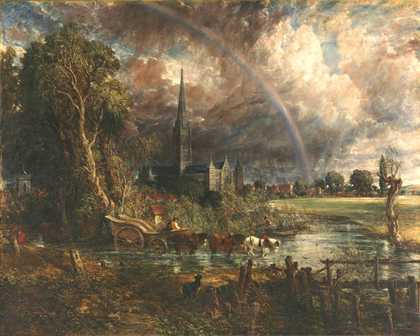
Fig.1
John Constable
Salisbury Cathedral from the Meadows exhibited 1831
Oil on canvas
1537 x 1920 mm
Tate T13896
Photo © Tate
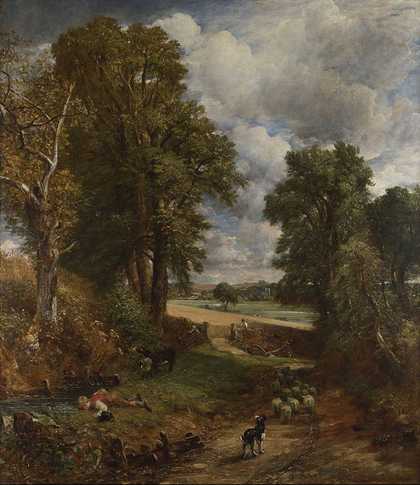
Fig.2
John Constable
The Cornfield 1826
National Gallery, London
Shortly after John Constable’s death on 31 March 1837, a committee assembled to choose a work from those left behind in his studio for acquisition by the National Gallery, London.1
The lush green idyll of The Cornfield 1826 (National Gallery, London) was selected. According to the artist’s friend and biographer C.R. Leslie, Salisbury Cathedral from the Meadows exhibited 1831 (Tate T13896; fig.1) was overlooked because ‘the boldness of its execution rendered it less likely to address itself to the general taste’.2
Indeed, as if to say the work defied explanation, one critic had responded to the wild handling of paint and fraught atmospherics with the simple statement that ‘Constable is Constable’.3
Yet Salisbury Cathedral from the Meadows shows us a very different Constable to that of The Cornfield 1826 (fig.2) and The Hay Wain 1821 (fig.3). It is on these East Anglian pastorals that Constable’s position as one of the nation’s favourite artists rests: The Hay Wain gained the nineteenth-century landscape painter second place in polls of the best-loved paintings in 2005 and 2014, and it featured alongside a portrait of Constable in the 2015 redesign of the UK passport as an emblem of the British countryside.4
However, as Leslie went on to explain, Salisbury Cathedral was the work that indicated ‘the fullest impression of the compass of [Constable’s] art’ and, as this study will show, this large canvas, which its artist referred to as his ‘great Salisbury’, was repeatedly promoted by him at several exhibitions, and continued to occupy him as he
worked on the print deriving from it in the last days before his
death, a full eight years after its origination.5
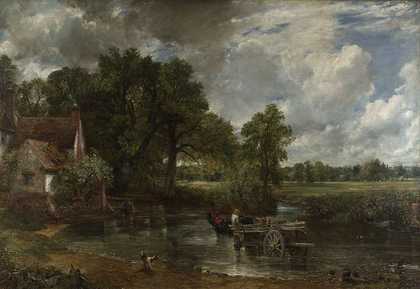
Fig.3
John Constable
The Hay Wain 1821
National Gallery, London
The ‘six-footers’ and Salisbury
At nearly two metres, or six feet, across, Salisbury Cathedral from the Meadows was designed to be noticed. It belongs in the category of paintings that have come to be known as Constable’s ‘six-footers’, a highly varied group of thirteen paintings produced between 1819 and the end of his life, each measuring around six feet wide by four high.6 In accordance with his wider oeuvre, the majority subject of these large pictures is Constable’s native Suffolk, epitomised by The Hay Wain. This was the landscape of his ‘careless boyhood’ which, he said, had ‘made [him] a painter’.7 Viewed this way, Salisbury Cathedral from the Meadows, along with Tate’s other six-foot canvases – such as The Opening of Waterloo Bridge (‘Whitehall Stairs, June 18th, 1817’) 1832 (Tate T04904), Chain Pier, Brighton 1827 (Tate N05957) and Sketch for ‘Hadleigh Castle’ c.1828–9 (Tate N04810) – emerge as geographically disparate and peripheral six-foot subjects, a status confirmed by the popular perception of the artist as being rooted in ‘Constable Country’.
Born into a prosperous family in the village of East Bergholt, Suffolk, Constable’s early display of aptitude and passion for painting led to his being freed of the obligation to enter his father’s business of grain milling and goods shipping on the River Stour, although his experience of this work gave him the intimate knowledge of the local landscape that fuelled his lifelong compulsion to depict it. In 1799, at the age of twenty-three, he moved to London and began training at the Royal Academy of Art. He developed his principles as a landscape painter based on his exposure to the work of Richard Wilson and Thomas Gainsborough, eighteenth-century pioneers of the genre in Britain, and the seventeenth-century French painter Claude, as well as through the mentorship he received from the tastemaker, collector and amateur artist Sir George Beaumont and the contemporary landscape painter Joseph Farington, who was heavily involved in the running of the Academy. Constable’s first accepted submission to the annual Royal Academy exhibition was a Suffolk landscape, The Edge of a Wood 1802 (Art Gallery of Ontario, Toronto), but much to the artist’s frustration, it was portraiture and not landscape that provided his consistent income well into the 1820s. Constable’s dissatisfaction with his public reputation is well documented in the large corpus of his surviving correspondence, through which his career appears as a long and persistent struggle to prove his worth as a landscape painter, be that to the Bicknell family, who thought him an unworthy match for their daughter Maria (the pair married in St Martin’s in the Fields, London, on 2 October 1816), to the public, to the critics or to the Academicians, in whose hands his professional recognition rested.
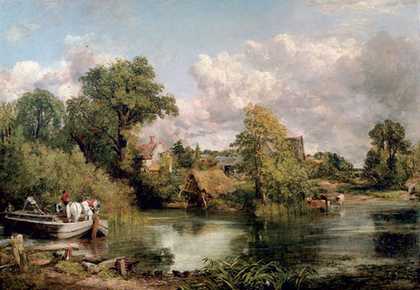
Fig.4
John Constable
The White Horse 1819
Oil on canvas
1314 x 1883 mm
Frick Collection, New York
No doubt it was Constable’s repeatedly frustrated attempts to gain election to the Academy and his desire to solicit attention from the critics that spurred him to enlarge his canvases to the six-foot scale. Not only would this format amplify his presence in the dense hang of the Academy’s annual exhibitions but it also drew a link between the aspiring Constable and his role models Gainsborough, Wilson and Farington, who had set a prestigious precedent for exhibiting large landscapes. Constable had experimented with a larger canvas size (a ‘half-length’ at 127 x 102 mm) in bids for recognition in 1813 and 1817, but it was not until his debut six-foot canvas, a summer scene of working life on the River Stour named The White Horse 1819 (fig.4), that critics engaged more seriously with his work. When in 1820 Constable was elected an Associate of the Royal Academy, the first step to becoming a full member, it must have seemed like this upscaling to a six-foot canvas had worked. It became his favoured format for the expression of his most ambitious compositions, the paintings he sought to be defined by. So enthused had be become by the larger canvas that in 1821 he wrote: ‘I do not consider myself at work unless I am before a six-foot canvas’.8 Constable had augmented his preparatory process for The White Horse by making a six-foot sketch in which the composition, light effects and colouring were tested at full-scale, an interim stage which then became an integral part of the process by which subsequent six-footers were made.9 The production of sketches on such a large format was a novel step but it was also an expensive one: two large canvases meant risking double the outlay on time and materials for the potential sale of only one (for Constable never sold his sketches, and does not appear to have used the reverse of any of the six-foot sketches). Complaining that ‘painting these large pictures have [sic] much impoverished me’, Constable appealed to his friend John Fisher for ‘a loan of £20 or £30’ in 1822.10 In various ways discussed below, this friendship would become an important factor in the production of Salisbury Cathedral from the Meadows.
In 1812 Fisher had sent Constable a letter which, as curator Anne Lyles has pointed out, likely catalysed Constable’s shift towards bigger, more impactful pictures. Fisher wrote to appraise a painting Constable had gifted him, which was
most pleasing when you are directed to look at it – but you must be taken to it. It does not sollicit [sic] attention – And this I think true of all your pictures & the real cause of your want of popularity.11
That Fisher could be so direct with his correspondent is testament to the speed and intensity of the bond that had developed between the two men after their first meeting in Salisbury only a year earlier, in 1811. Constable visited Salisbury for the first time upon the invitation of Fisher’s uncle, the Bishop of Salisbury, a man with art world connections who had been a founder member of the British Institution, was chaplain to the Royal Academy in 1806, and had taken an interest in Constable’s career. The Bishop, also called John Fisher, entrusted his nephew to be the artist’s guide for the duration of his visit and from this point on, united by their Anglican faith and a shared love of art (Fisher was an amateur painter and, like his uncle, purchased works from Constable), the men forged a jocular, mutually supportive bond that the artist described in a letter to Fisher as ‘at once the pride – the honour – and the grand stimulus of my life’.12 Fisher, ordained a priest in 1812, came to settle in the Cathedral Close at Salisbury and was joined there by Constable on several occasions that included the artist’s honeymoon in 1816, a seven-week stay in 1820 and further visits in 1821 and 1823. These visits, and the raft of sketches in pencil, watercolour and oil he produced during them – numbered by art historian Timothy Wilcox as at around 300 works – endowed Constable with a familiarity and a fondness for the built environment of the Cathedral Close, the town of Salisbury and the Wiltshire hinterland beyond.13
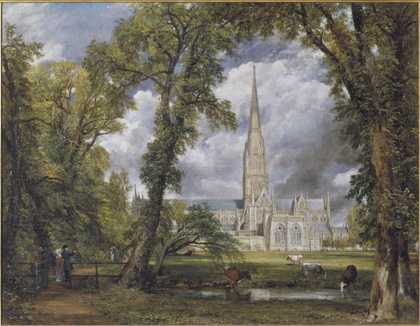
Fig.5
John Constable
Salisbury Cathedral from the Bishop’s Grounds 1823
Victoria and Albert Museum, London
© Victoria and Albert Museum
Salisbury Cathedral from the Meadows was the third and last of the finished, exhibited oil paintings that arose from this material. The first, Salisbury: Morning 1812 (untraced), was undoubtedly on a smaller scale and was possibly the picture that Fisher had come to own and appraise in his letter. Although not singled out for specific attention, this and his other 1812 Royal Academy exhibits earned Constable a place in critics’ roll calls of notable contributors in the field of landscape.14 His next Salisbury painting, also smaller at 876 x 1118 mm (2.9 x 3.6 ft), came eleven years later in the form of Salisbury Cathedral from the Bishop’s Grounds 1823 (fig.5). The existence of three versions of this latter offering, discussed below, attests to the void that had begun to open up between Constable’s personal vision for an expressive, animated landscape, and the picturesque expectations of his patron, which reflected those of the wider public at that time.
Constable’s patron for Salisbury Cathedral from the Bishop’s Grounds was the Bishop, who had encouraged the artist to develop it from a sketch.15 Despite having been ‘dreading’ work on this, which he referred to with typical hyperbole as ‘the most difficult subject in landscape I ever had upon my easil [sic]’, Constable was pleased enough to submit it to the Academy’s annual exhibition, although he was anxious that this would be the first year since 1819 that he would not be represented by a six-foot canvas.16 The artist reported his difficulty with this smaller Salisbury canvas to be the depiction of the cathedral’s celebrated Gothic architectural detail, its ‘windows, buttresses, &c, &c,’.17 The ultimate difficulty and cause for reworking the painting was the Bishop’s unease at the dark clouds with which Constable had animated the sky. A new, sunnier version was thereby produced (Salisbury Cathedral from the Bishop’s Grounds 1823, Huntington Collection, San Marino), which the Bishop gave to his daughter as a wedding present, but Constable had not yet finished a third version for the Bishop before the latter’s death in May 1825. This third one – Salisbury Cathedral from the Bishop’s Garden (Frick Collection, New York) – was finished a year later, in 1826, and given to the Bishop’s widow. Fisher, meanwhile, purchased the original (fig.5) with its ‘dark cloud’ but was forced to sell it back to the artist in December 1829, having fallen on hard times. This ‘dark cloud’ painting of Salisbury, replete with unfortunate provenance, was thus back in Constable’s studio at the very moment he began working on his third and final painting of that same landscape, Salisbury Cathedral from the Meadows.
The genesis of Salisbury Cathedral from the Meadows
Fisher’s friendship has been ascribed an important role in the genesis of this painting on the basis of a letter he wrote to Constable in August 1829:
The great easil [sic] has arrived & waits his office. Pray do not let it be long before you come & begin your work … It will be an amazing adventure to go every day & look afresh at your materials drawn from nature herself.18
Conveying the same effusive tone that ran through much of their correspondence, this letter suggests the idea for a six-foot painting of Salisbury had arisen during Constable’s visit there in July 1829, and that there was at least the intention on Constable’s part to begin work on a six-foot canvas, most likely the sketch, in Salisbury. This would have indeed been an ‘adventure’ in its departure from Constable’s usual practice of working in his Charlotte Street studio in London, to which he had moved in 1822 and where there was more space for six-foot canvases compared to his previous one at nearby Keppel Street.19 Earlier in 1829 Constable had written to C.R. Leslie expressing a wish for escapism via the means of a large painting: ‘could I get afloat on a canvas of six feet, I might have a chance of being carried away from myself’.20 He presumably wished to be ‘carried away’ from his grief after the death of his wife Maria, the mother of their seven young children, in November 1828. In light of this, Fisher’s letter might also then reveal his championing of a positive focus around which to structure their friendship after years that had seen the deaths of the originator of their friendship, the Bishop (in 1825), of Constable’s wife, and which had visited financial woe upon Fisher. Salisbury Cathedral presented a project that both men could be enthused by, rooted, as it was, in the landscape they both carried an affection for: it was here that they had first met and shared happier times with their families. Fisher’s use of the word ‘office’ in his light-hearted personification of the blank canvas is perhaps a deliberate evocation of a congregation awaiting delivery of a church service, intended by him to buoy his friend’s enthusiasm and confidence in the endeavour. His motivational drive continued in later correspondence when he urged Constable to devote the autumn months to work on this project, knowing, as he did, how his friend’s productivity tended to dip during winter.21
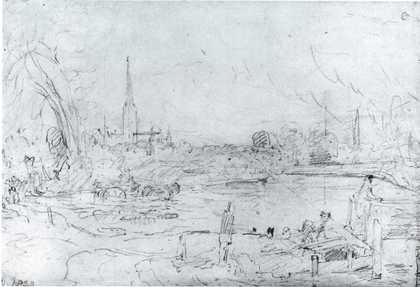
Fig.6
John Constable
Salisbury Cathedral from Long Bridge 1829
230 x 325 mm
Lady Lever Art Gallery, Liverpool
Constable spent a total nearing five weeks in Salisbury in 1829: three weeks in July and a further two in November on a visit which would be his last. These visits gave rise to around thirty-eight studies in pencil, watercolours and oils in which the Salisbury landscape can be identified.22 Four drawings in pencil and three oil sketches directly relate to the composition of Salisbury Cathedral from the Meadows and show the artist working through ideas for colour schemes, atmosphere and figures. Two pencil sketches are thought to have been made in July, judging by the full foliage on the trees,23 while another (fig.6), as Wilcox has suggested, can be confidently assigned to November from its inscription of ‘11.1829’, a presumable indication of the month it was made.24 Evidently satisfied that this composition represented the best combination of ideas first expressed in the two July drawings, this design was squared up so that it could be transferred and developed on a larger scale in the oil sketch Salisbury Cathedral from the Meadows ?1829 (Tate N01814), which was then itself squared up using threads – indicated by regularly spaced holes at the canvas edges – for transfer of the design to the six-foot sketch (fig.7).25 From the making of the pencil sketch it would be another twelve months until the artist turned his full attention to production of a six-foot version of the composition, despite encouragement from Fisher, who had hoped to see the finished canvas exhibited in 1830. It must be said, however, that by comparison with other large-scale paintings, particularly the fourteen-year incubation of The Opening of Waterloo Bridge (‘Whitehall Stairs, June 18th, 1817’), Constable’s Salisbury Cathedral was conceived, developed and exhibited within a relatively short space of time.
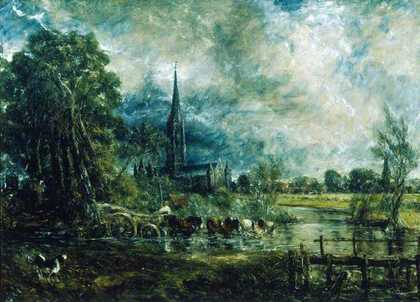
Fig.7
John Constable
Salisbury Cathedral, Wiltshire, from the Meadows c.1829–31
Oil on canvas
1335 x 1860 mm
Guildhall Art Gallery, London
Like most of the other six-footers, Salisbury Cathedral and its full-scale sketch are painted on plain weave linen canvas.26 The size and shape of each canvas in the series varies in accordance with Constable’s original intentions, changes he made, or subsequent alterations to the canvases in the years since his death. The Lock 1824 (private collection) is uniquely portrait in orientation, while Chain Pier, Brighton started out larger but was cut down by Constable to the size of a regular six-footer after its exhibition in 1827; Salisbury Cathedral from the Meadows is the most square of the group.27 Comparison of Salisbury Cathedral with the more rectangular full-scale sketch held at the Guildhall (fig.7) shows how this additional six inches (or 15 centimetres) of height aids the centripetal composition of the finished painting, in which the cathedral’s central force is emphasised by the circular path effected by the rainbow, the tree and the River Nadder, with its wading horses and cart. The eye is encouraged to follow the river – an undulating ‘line of beauty’ of the kind that artist William Hogarth (1697–1764) identified in ‘winding walks, and serpentine rivers’28 – into the heart of the composition, through the glistening thicket, up the tree trunk and back down along the arc of the rainbow. This additional height also allows for a lengthened foreground path and a greater sense of depth, although the painting retains some of the lateral thrust of the wider-angled sketch. This strong horizontal emphasis encourages us to take in the composition’s peripheral features.
By comparison to the thick layers of impasto in the centre of the canvas, the far right portion of the painting is given a distinct serenity by its unity of light tones and textural homogeneity – Constable has used predominantly horizontal brushstrokes to describe the Harnham Water Meadows and the streaked, glassy surface of the river. In the right-hand foreground is the Nadder, which flows into the Avon as it reaches the bounds of the Cathedral Close; on the left is the smaller overflow stream of the ‘back’ Avon, now no longer there.29 Given that all of his six-foot paintings feature water, Constable clearly felt a compulsion towards it (perhaps owing to its presence in his upbringing on the banks of the Stour) but in Salisbury this was particularly apposite. Lack of water had motivated the twelfth-century clergy to remove the cathedral from Old Sarum to its present site, while an 1830 account of the city by an associate of Constable’s, the antiquarian writer John Britton, described the rivulets running through Salisbury’s streets as a ‘singularity’. Furthermore, as landscape historian Charles Watkins describes in this In Focus, the carefully managed water meadows in the immediate vicinity of the cathedral (the Harnham Meadows) were a particular source of regional pride and prosperity.30 It is thus appropriate for the cathedral to be presented as a hulk of stone in a watery landscape, its spire piercing the cloud-filled sky.
The cathedral and its environs
Styled ‘cathedral man’ by Wiltshire landowner and antiquarian William Beckford, John Britton declared cathedrals to be ‘the most important and interesting of our national antiquities’.31 In a book which Constable is known to have owned, Britton had singled out Salisbury as preeminent, for
Unlike other cathedrals, which are mostly situated in the midst of incongruous buildings … [it] stands so detached from human habitations, that a free view of its regular form and unity of parts is obtained from almost every point.32
The structure’s ‘regular form and unity of parts’ owed to its being executed largely in one phase, between 1220 and 1258. On his first visit to the Cathedral Close in 1811 Constable would have experienced the ‘free view’ of the cathedral ‘from almost every point’ that Britton described. Yet this viewing experience had been realised through controversial means. In the spirit of the picturesque – a mode of view-making emphasising order and regularity that was disseminated by the writings of the Reverend William Gilpin (who happened to hold a prebendary stall at Salisbury Cathedral) – the architect James Wyatt made a series of interventions between 1786 and 1792 that were intended to accentuate the cathedral’s visual appeal. The graveyard was cleared, gravel walkways were laid on newly levelled ground and some elements of the cathedral, such as chapels that post-dated the original phase of building, were pulled down. A fierce debate erupted as to the propriety of these works. To his sympathisers, amongst them Britton, Wyatt was streamlining and returning the cathedral to its original form; to his detractors, however, Wyatt was ‘the Destroyer’ and ‘the Vandal’ of one of Britain’s most important historic buildings.33
In the late 1820s Constable became more interested in antiquarian culture. He would have known of the controversy surrounding Salisbury Cathedral’s appearance, for the debate simmered on in publications like guidebooks, which heaped either praise or scorn upon Wyatt’s intervention. By evading close-up representation of the cathedral in his six-foot painting, Constable perhaps hoped to appeal to all parties with an antiquarian interest in the building, whatever their stance. It also served to mitigate against the need to finely render the cathedral’s architectural detail, a task which had contributed to his difficulty in painting Salisbury Cathedral from the Bishop’s Grounds (fig.5) and caused one critic, writing in the Morning Chronicle, to respond that ‘less attention to detail would have been better’.34 The breadth of touch with which Constable described the cathedral in Salisbury Cathedral from the Meadows was perhaps also conditioned by the practicalities of his preference at this stage for thicker layers of paint, as well as expectations of oil paintings in general. Academically, this was a lowly topographical subject more commonly represented in watercolour and print than in oil, as can be seen in George Fennel Robson’s engraving South-West View of the City of Salisbury 1827 (fig.8) and Turner’s graphite and watercolour work Salisbury Cathedral from the East c.1798 (Tate D00668; fig.9). To paint it in oil on such a scale as the six-foot canvas was therefore to forge new ground.
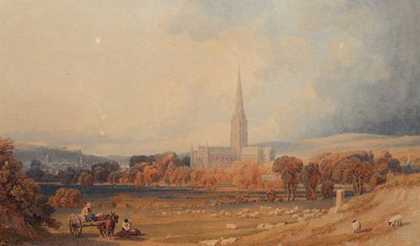
Fig.8
George Fennel Robson
South-West View of the City of Salisbury 1827
Salisbury and South Wiltshire Museum, Salisbury
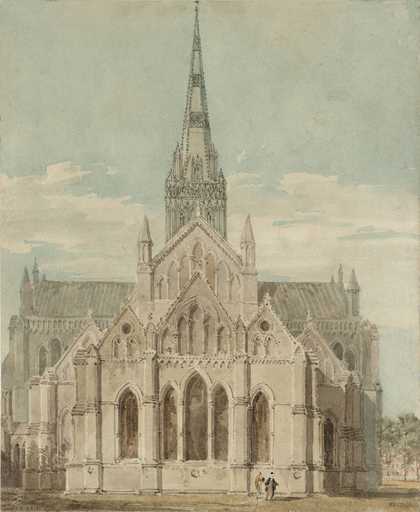
Fig.9
Joseph Mallord William Turner
Salisbury Cathedral from the East c.1798
Tate D00668, Turner Bequest XXVII G
Photo © Tate
Compositionally, too, Salisbury Cathedral sits apart from the majority of views of Salisbury produced up to that point. It was common for the cathedral to take precedence, either through the drama of its silhouette, piercing the sky and denoting the city’s location like a pin on a map, or else by filling the picture plane in images that allowed the intricacies of its architecture to be appreciated (see Turner’s Salisbury Cathedral from the East, fig.9). The city was largely concealed from view, or else distanced and miniscule by comparison to the majestic stature of the cathedral. Constable, however, firmly roots the sacred building into the landscape around it. His cathedral nestles among and connects the urban and the rural, becoming a conduit between city and meadow – man and nature – in what perhaps amounts to a manifestation of the artist’s faith in the Church as an agent of a harmonious, prosperous and virtuous society.
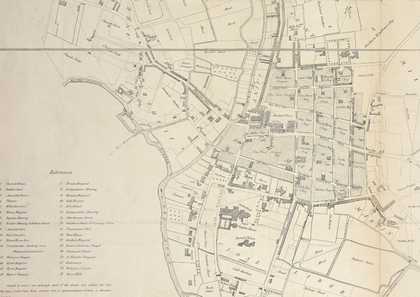
Fig.10
Plan of the City of Salisbury, with the Boundaries of the Borough, as Laid Down by the Reform Act. Surveyed by G.O. Lucas, [Salisbury?] 1833, detail showing Fisherton Mill and Salisbury Cathedral
British Library, London
© British Library Board, Cartographic Items Maps 5730. (1.)
In the painting, the buildings in the cathedral’s immediate surroundings are those of the Cathedral Close, which covered an area so large as to be described by writer Daniel Defoe in 1792 as ‘like another city’.35 Past tension between cathedral and city is indicated by the red-brick wall, built in 1327 to protect the clergy, bounding the Close at the edge of the meadow on the right-hand side. The house immediately to the left of the wall has been identified as Leadenhall (sometimes spelled ‘Leydenhall’), the house in which Constable’s friend Fisher lived and in which the artist had stayed when the idea for Salisbury Cathedral was hatched; it was demolished in 1917.36 The treatment of other buildings, however, for example the terracotta-roofed structures just left of the centre, exhibit Constable’s disregard for topographical veracity, a frequent trait of his work by the late 1820s.37 Assuming Constable’s viewpoint to be a position on the bank of a bend in the River Nadder just by Fisherton Mill, a near-contemporary map (fig.10) offers no sign of any building upon this river island, nor do these structures appear in the pencil sketch closest to the painting in composition that is thought to have been made on his July visit (Fitzwilliam Museum, Cambridge; fig.11).38 The building in this position in the Guildhall’s six-foot oil sketch is larger and more plausible as an outbuilding or, to a lesser degree, a building in the north-west corner of the Cathedral Close. In the final painting, however, a confused sense of perspective arises from the disparity of scale between the red-roofed buildings and the figure on the cart.

Fig.11
John Constable
Salisbury Cathedral from the North West 1829
Fitzwilliam Museum, Cambridge
Constable also appears to flout topography and perspective in his depiction of the second most recognisable building in the painting after the cathedral, the church of St Thomas at the far left. Sitting outside the bounds of the Cathedral Close, this was one of the original sites of worship in Salisbury, or New Sarum as it was then called, founded in 1240 as a chapel-of-ease to the cathedral, which was then just over half way through its construction.39 Barely detectable in the Fitzwilliam Museum pencil drawing (fig.11), St Thomas’s became gradually more prominent as Constable worked his composition up in tandem with increases in the size of his support – in Salisbury Cathedral it is given identifiable detail and defined sufficiently enough to attract the eye, with help from the bright red garb of the figure in the foreground and the obsolete, slanting gatepost, most likely a remnant of the apparatus surrounding the defunct Fisherton Mill. We are clearly meant to notice the church and yet by consultation of the map, it would seemingly not be visible from Constable’s vantage point. Compositionally, however, it provides a focal point for the avenue recess in foliage on the left, a device to pull the eye to the deepest realm of pictorial space. Such a device was frequently seen in paintings by Claude (such as his Landscape with Jacob, Laban and his Daughters 1654, Petworth House, West Sussex), whose work continued to provide inspiration to Constable in his late years. St Thomas’s, by its proximity, serves to emphasise the physical and spiritual relationship between cathedral and city.
Man and nature
Constable presents the cathedral and its watery landscape as the crux of another harmonious relationship, that between man and nature. A grazing cow, just to the right of the figure in red, indexes the wealth of livestock to be found there, which dominated the foreground in Constable’s previous depiction of this landscape, Salisbury Cathedral from the Bishop’s Grounds.40 Meanwhile, in the composition’s centre a cart fords the Nadder, crossing the path of a small barge propelled by a man emerging from the reeds; the dog in the foreground is a collie, a breed used for herding livestock in Britain since Roman times. Recalling Leslie’s description of this painting as ‘the fullest impression of the compass of his art’, these elements direct us towards the touchstone subject in Constable’s oeuvre – the working life of the River Stour and the East Anglian landscape. While the dog is taken directly from The Cornfield (fig.2), the cart is reminiscent of that in The Hay Wain (fig.3), modified here to display the characteristics of a particular kind of vehicle, the bow-wagon, specific to the south-west region of England.41

Fig.12
David Lucas after John Constable
Salisbury Cathedral from the Meadows – ‘The Rainbow’ 1837
Victoria and Albert Museum, London
© Victoria and Albert Museum
Water again prevails in the vaporous spectacle of the rainbow which has been discussed as another potential visual anomaly.42 As John E. Thornes further elucidates elsewhere in this In Focus, Constable was a keen observer of atmospheric effects and, like many artists, kept abreast of developments in the burgeoning science of meteorology.43 His depictions of skies show him alternatively prioritising accuracy and artistic license according to purpose – the rainbow in Salisbury Cathedral, which is unlikely to have been visible from this viewpoint with sunlight falling from the right-hand side, is seemingly an example of him privileging the latter. Salisbury Cathedral was developed at a time when Constable was increasingly interested in the ethereal effects of rainbows. In a lecture he gave in Worcester in 1834, Constable spoke about the Flemish artist Peter Paul Rubens’s ability to depict ‘more than the rainbow itself … dewy light and freshness, the departing shower, with the exhilaration of the returning sun’ in paintings like The Rainbow Landscape c.1635 (Wallace Collection, London).44 Constable also copied out William Wordsworth’s 1807 poem The Rainbow in 1830, the year in which he added a rainbow to the mezzotint made after his painting Stoke-by-Nayland.45 Furthermore, just as St Thomas’s Church became more prominent in the composition as it developed from sketch to final canvas, Constable assigned greater significance to the rainbow in Salisbury Cathedral from the Meadows as he saw through the production of the mezzotint after the painting in collaboration with his printmaker David Lucas (fig.12), subtitling the print ‘The Rainbow’ and writing to Lucas that ‘it forms the subject of the picture’.46
In October 1821 Constable wrote in a letter to Fisher that the sky was, for him, the ‘chief organ of sentiment’ in a painting.47 The sky in Salisbury Cathedral from the Meadows, with its rainbow and dark clouds, is thus the hook upon which the painting’s two main interpretative contexts to date have been hung: the private life of the artist and the public affairs of national politics. Taking Constable’s personal life as a springboard, the storm clouds have been perceived as indexing the artist’s grief in the wake of his wife’s death, and the rainbow a symbol of divine solace. As historian Paul D. Schweizer has pointed out, the rainbow comes to rest on Leadenhall, Fisher’s home in the Cathedral Close, and as such may be a tribute to him.48 The absence of any mention of the rainbow in descriptions by critics reacting to the painting on its debut showing in 1831 – critics who, as detailed below, fixated on the ‘chaos’ of Constable’s sky – as well as our knowledge from Constable’s correspondence that he reworked the painting after its debut, point towards the possibility that the rainbow was a posthumous tribute, added after Fisher’s death on 25 August 1832. This suggestion is advanced in Thornes’s essay in this In Focus.49
Fisher is also implicated in the other, more public, sphere of meaning that art historians have perceived in the painting. In the same letter in which he gave encouragement to Constable to begin work on the six-foot painting in Salisbury, dated August 1829, Fisher wrote: ‘I am quite sure the “Church under a cloud” is the best subject you can take’.50 Given that Constable’s difficulties with his earlier painting of the cathedral, Salisbury Cathedral from the Bishop’s Grounds, had revolved around the ‘dark cloud’ that proved unacceptable to the Bishop, this phrase could resonate as motivation to the artist to further develop his thesis on the atmospheric charge that storm clouds gave to the cathedral landscape. However, the context of agitation for constitutional reform, which gathered pace in the 1820s, and the anti-reform ideology shared by the two men, galvanises the potential for the painting to be cast as a self-consciously public statement on a highly contentious and topical matter, as historian Brian Young discusses in more detail in another section of this In Focus.51
Church imagery itself was not unusual, being a cornerstone in topography and antiquarianism, disciplines that were reaching their zenith at the time Salisbury Cathedral was painted. Constable’s associate Britton looked beyond aesthetic grandeur to posit cathedrals as bastions of national pride which upheld their hinterlands’ productivity and morality, a view that promoted the close relationship between Church and State as a harmonious one, beneficial to the nation. Reform movements demanding equality for British Catholics in civil positions and an overhaul of the electoral system challenged this image and posed a threat to the Anglican Church’s role in the governance of Britain. A sermon published in 1830 by John Miller, Rector of Benefield, Northamptonshire, makes plain the anxiety felt by the Church, characterising the debate as ‘ungenerous clamour round about the sanctuary’ by a ‘variety of enemies all ready to rush in and build up their own visionary schemes … upon [the Church’s] ruins’.52 Constable and Fisher had themselves exchanged worried letters regarding the political climate. In response to Fisher having stated that the ‘vulture of reform’ was ‘now turning its eyes on the Church’, Constable wrote in 1823:
I am sorry to see that you are again haunted by that Phantom – ‘The Church in Danger’ – it does not speak a just state of mind or thinking. That the Vultures will attack it and everything else, is likely enough.53
Salisbury Cathedral itself appears to have been a touchstone reference for the Church by the 1830s, the height of its spire lending it a symbolic power called on by politician Sir George Henry Rose, who was reported to have said that ‘he beheved [sic] those who saw the spire of Salisbury Cathedral or the cross of St. Paul’s in their present places 30 years after the passing of the [Reform] Bill would have better eyes than he expected them to have’.54 Wilcox has asserted that Constable would have been ‘naïve if he had imagined the contemporary resonance of the image would not be registered’.55 By the time Constable came to add the rainbow, if this was indeed in 1832 after the death of Fisher, the Representation of the People Act (more widely known as the Great Reform Act) had been passed, resulting in changes to the electoral system for fairer representation of the citizens of England and Wales, and the Church had largely weathered the brunt of that particular storm.56
Replete with pathetic fallacy, the lines that Constable chose to append to Salisbury Cathedral from the Meadows in the catalogue accompanying its 1831 exhibition have fuelled these interpretations of the painting:
As from the face of heaven the scatter’d cloud
Tumultuous rove, th’interminable sky
Sublimer swells, and o’er the world expands
A purer azure. Through the lightened air
A higher lustre and a clearer calm
Diffusive tremble; while, as if in sign
Of danger past, a glittering robe of joy,
Set off abundant by the yellow ray,
Invests the fields, and nature smiles reviv’d.57
This passage came from ‘Summer’ in the 1730 poem The Seasons by James Thompson, which was a popular literary source for painters wishing to aggrandise their landscapes with added emotive charge. With its overarching theme of man’s fate being in the hands of Godly magnitude and the forces of nature, ‘Summer’ was particularly popular with artists such as Turner. The reference in Thompson’s ‘Summer’ to the story of the mythical lovers Celadon and Amelia, the latter of whom, after being struck by lightning, dies in her lover’s arms, may have resonated particularly with Constable after the death of his wife in 1828. The following year he appended a quotation from the same poem to Hadleigh Castle, The Mouth of the Thames – Morning after a Stormy Night 1829 (Yale Center for British Art, New Haven), a melancholy landscape that is more overt in its potential to be interpreted as an expression of grief, with its motif of a ruined tower and a lone shepherd in a bleak, blustery landscape.
First display and reaction, 1831
It was likely not only grief that steered Constable towards the grander themes, heightened drama and bravura handling of paintings like Hadleigh Castle, Salisbury Cathedral from the Meadows and The Opening of Waterloo Bridge. In February 1829 Constable’s ten years as an associate of the Academy were over and his professional ambition was fulfilled by his election – won by a single vote – to full membership of the Royal Academy.
Constable was afforded the privilege of serving on the hanging committee for the Academy’s annual exhibition of 1831, giving him the authority to position Salisbury Cathedral as he liked. It hung in the Great Room, the most prestigious display space at New Somerset House, and, deducing from the number it was assigned in the sequence, 169, it hung relatively close to Turner’s Caligula’s Palace and Bridge (Tate N00512), numbered 162. Turner apparently ridiculed Constable at a dinner party for having moved Caligula’s Palace from a more prominent position and replaced it with Salisbury Cathedral; but could Constable have kept them close so as to actively invite comparison in a spirit of defiant competition?58 Constable’s reputation as a key player in the field of landscape painting had been established, in part, on the back of comparison with Turner, first iterated in criticism of his initial six-foot painting, The White Horse of 1819. The juxtaposition of their work in 1831 inspired the lyrical comparison of their work as ‘Fire and water … the one all heat, the other all humidity’; the watery landscape in Salisbury Cathedral inspired this critic to pronounce Constable a ‘Neptunist’, one subscribing to the theory that water drove geological change.59
The finish, surface texture, patchwork of light and dark, and definition of form (or lack thereof) of Salisbury Cathedral from the Meadows stoked the fire of a decade’s worth of anxieties about Constable’s work such that in general the painting garnered bemusement and outright disdain from the critics. This was one score on which he was level with Turner, whose later work was also the source of much ridicule in the press. As much as Constable was buoyed by positive remarks that punctuated reviews – he cited in a letter one which concluded that despite its ‘chaos of the elements, [Salisbury Cathedral] is impossible to pass by without admiration’ – he wearily noted that ‘[t]he papers still abuse the Exhibition and the painters’.60 The Athenaeum’s critic presumed the painting’s subject to be the ‘clearing up of a shower’, based on the appended quote from Thompson, but decided, ultimately, that ‘there is nothing like a clearing up about it’, and that it was ‘painful’ to look at; another deemed the clouds ‘too theatrically stormy’61 while the Morning Herald’s critic railed that ‘the sky is in a state of utter derangement’.62
The sky was the first area of the canvas to be painted, worked thinly using large brushes, and then scraped back in parts to reveal the pink-brown ground.63 Although critics deemed the sky ‘too purple’, with ‘plum colour’ rain,64 it is this bruise-like colouring that so effectively creates a backdrop of disquiet to a landscape that is given a sculptural and correspondingly turbulent texture, comprised of dots, dabs and strokes of pure colour that arise from liberal use of the palette knife. Perceived as ‘a confusion of colours’ and displaying ‘a smudginess of effect’, the painting’s mottled colouring and sculptural surface texture was much in contrast to the minute detail and smooth finesse of paintings by contemporaries such as David Wilkie, William Mulready and Edwin Landseer. Indeed, debate as to the correct distance from which Constable’s dabs would come into focus as trees, people or other forms had been a prevalent feature in criticism of his work since as early as 1812.65 That Constable may have painted Salisbury Cathedral with his toes was the glib conclusion of a notoriously punishing critic, Edward Dubois, whose vitriol would later lead the artist to consider legal action.66 An uneasy echo of the critics’ sensationalist response to Salisbury Cathedral, giving an insight into why his fellow artists took so long to promote him to full Academician status, is found in a letter of July 1831 to the painter Nathaniel George Phillips from sculptor and Academician Richard Westmacott, who thought the painting ‘full of talent but very odd – most coarsely painted, it looked as if it were worked in worsted & had then been powdered’.67 In 1823 Westmacott’s son, the journalist Charles M. Westmacott, had made what appears to be the first mention of ‘snow’ in his critique of Salisbury Cathedral from the Bishop’s Grounds:
there is a flittering mannerism in his foliage and handling which gives to all his trees and herbage the appearance of sleet or snow having fallen.68
Thereafter, Constable’s ‘snow’ became a favoured critical trope and was bandied with particular zeal by critics in 1831, who perceived in Salisbury Cathedral from the Meadows ‘glittering white speckly effects so offensive to the eye’ and ‘snow … melting away’.69 The foreground was thought to have suffered a ‘shower of meal’70 or, as the Times disingenuously conspired, had been sabotaged by way of another artist ‘spotting [it] all over with whitewash’.71 It was perhaps a sign that Constable had internalised their earlier epithets and the allegations of his ‘mannered’ handling that veered from ‘truth’ when he wrote to Fisher in 1830, while working on Salisbury Cathedral, that
I have filled my head with certain notions of freshness – sparkle – brightness – till it has influenced my practice in no small degree, & is in fact taking the place of truth so invidious in manner, in all things.72
Although twentieth-century criticism has looked far more favourably on Constable’s work, prizing his wild handling of paint as forward-looking, experimental and expressive, a 2007 biography by Anthony Bailey empathises with the decision of the National Gallery’s 1837 committee not to choose Salisbury Cathedral for acquisition on account that its ‘intensity is dearly bought’. Bailey’s postulation that Constable might be ‘[a]n English El Greco [1541–1614]’ strikes a comparison with the similarly individualistic Spanish painter whose work regularly displayed an unsettling charge through dark tonalities and striking flashes of light.73
Reworking and re-exhibiting, 1833–6
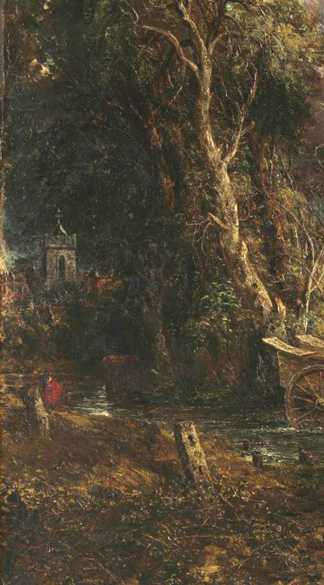
Fig.13
John Constable
Salisbury Cathedral from the Meadows, detail showing reworking, drying cracks and other changes on St Thomas’s Church and houses
Photo © Tate
Constable’s approach to his work played into the critics’ hands. Plagued by self-imposed pressure and fear of failure, he would procrastinate, run out of time, and be forced to submit paintings for exhibition that were not yet finished. This, plus sensitivity to criticism, the inability to be satisfied with his work and complications arising from his hasty technique compelled Constable to rework paintings post-exhibition. Although its return to the easel makes it impossible to know exactly how Salisbury Cathedral first appeared in 1831, research by conservator Sarah Cove has pinpointed features of his reworking as well as chemical changes that create obstacles in our reading that parallel those faced by its first public. Constable’s treatment of the houses at the far left, for example, whereby thick, globular paint was applied over layers that were almost dry, has caused cracks to form that dissolve the definition of form and tragically reduce the efficacy of Constable’s reworking (fig.13). The thicket of foliage below the cathedral has suffered from the discolouration over time and with exposure to impure air of its patent yellow, originally bright and citrus in tone and now a dull ochre; Constable’s lead white, on the other hand, has not altered, and thus sits in stark contrast to the dulled yellow such that each branch, twig and leaf is brilliantly highlighted and thrown into jarring relief against darker paint below.74 Constable spoke of the ‘mellowing hand of time’, implying an understanding of the changes that would occur in the material make-up and outward appearance of his paintings, however this muting of colour has collapsed both the contrast between shade and darkness, and between mid- and foreground, compounding the overall disjointedness of the composition and its unsettling appearance.75 Yet this effect – the extent of which is unintentional – lends drama and force to the painting that, combined with his radical laying of thick, impastoed paint, and his use of the pallet knife and a complex composition, demands more from the viewer than perhaps his contemporaries were prepared to give.
Constable was exceptionally committed to showing Salisbury Cathedral in public, going on to exhibit the work a further three times, perhaps motivated by pride or the desire to sell it. He first showed it again at the British Institution in London in 1833. Re-exhibiting works here after a first showing at the Royal Academy was not uncommon and Salisbury Cathedral was duly recognised amongst ‘old friends’ and thus not afforded much attention.76 It was perhaps here that it first appeared with the rainbow included, however no review makes mention of this change. The painting was evidently reworked for re-exhibition in Birmingham in the summer of 1834, as a letter from Constable to his friend William Purton reveals:
I have done wonders with my great Salisbury – I have been preparing it for Birmingham, and I am sure I have much increased its power and effect … I have no doubt of this picture being my best now.77
Furthermore, the first mention of the rainbow in the painting by any critic appeared in an article on this exhibition in the Birmingham Advertiser on 20 November 1834: ‘Aiming at some striking effect of a summer storm, the artist has covered his picture with a singular assemblage of white spots, and has rashly ventured, too, on that object, ever too ethereal for mortal pencil – a rainbow; which looks as if it were built there, and must there ever remain.’78
Constable, like many other London-based artists, took advantage of the burgeoning fine arts scenes in regional cities.79 He had exhibited work in Birmingham on three previous occasions and although it is possible that Salisbury Cathedral may have been a loan solicited by the increasingly ambitious Society of Artists to lend their show metropolitan pizzazz and prestige, the 1834 catalogue tells us the work was placed in the rather modest surroundings of the ‘Front Room, West’, rather than in the Great Room.80 At number 317, this was the furthest into their exhibition list that he had thus far been placed – perhaps his last-minute reworking of Salisbury Cathedral had, again, compromised its appeal.
Two years later it was exhibited at Worcester’s Athenaeum, where Constable had delivered lectures including that in which he spoke of Rubens. Here the painting’s catalogue number was 2 and it received an intriguing appraisal in the Worcestershire Guardian. According to its critic, Salisbury Cathedral was a painting for the ‘cognoscenti’, who were best placed to appreciate the ‘wonderful effect’ created ‘by the philosophical arrangement of colours’. The ‘amateur’ or the ‘many’, on the other hand, would delight more ‘at being transported into the pleasant fields’ of his other exhibit, presumed by Constable scholar R.B. Beckett to be The White Horse.81 As the art historian Judy Crosby Ivy points out, this review has the potential to index a sliding scale of accessibility in Constable’s work that placed Salisbury Cathedral on a more exalted, academic level than the lush green Stour landscapes of previous years.82
Constable was perhaps seeking to exaggerate the philosophical appeal of Salisbury Cathedral and draw attention to the significance – divine or otherwise – of its meteorological content through the addition of the rainbow and changes he made to its title and accompanying poetic passage. At Birmingham he appended the subtitle Summer Afternoon, A Retiring Storm, and swapped Thompson’s Seasons for Joseph Addison’s 1717 poem Story of Callisto:
No tracks of Heaven’s destructive fire remain,
The fields and woods revive, and Nature smiles again.83
Like the rainbow, which builds on the sunnier patch of sky to the right of the painting, this succinct excerpt more efficiently and emphatically iterates the theme of hope than the longer passage from Thompson, whether or not this change of reference arose from restrictions on space per exhibit in Birmingham’s exhibition catalogue. For its Worcester showing in 1836, the painting’s subtitle was changed slightly again to Summer Afternoon – A Retiring Tempest. These new subtitles give weather an equal footing with location in the picture’s title, bringing Salisbury Cathedral in line with the atmospheric emphasis of titles in Constable’s print portfolio, English Landscape Scenery (published in 1831). Here compositions depicting recognisable ‘Constable Country’ topographies such as Dedham Vale (for example Dedham from Langham ?1813, Tate N02654) were given generic titles in print, like Summer Morning. The Rainbow, the title for the print of Salisbury Cathedral from the Meadows on which Constable was still working in the days before his death on 31 March 1837 (fig.12), brings, by association, a sense of calm to a painting that constituted a battleground of meanings and which originated at a time of great turbulence, both private and public. These changes set in motion the process by which the painting’s layers of meaning, like the paint on its surface, are continually applied and evolving.
